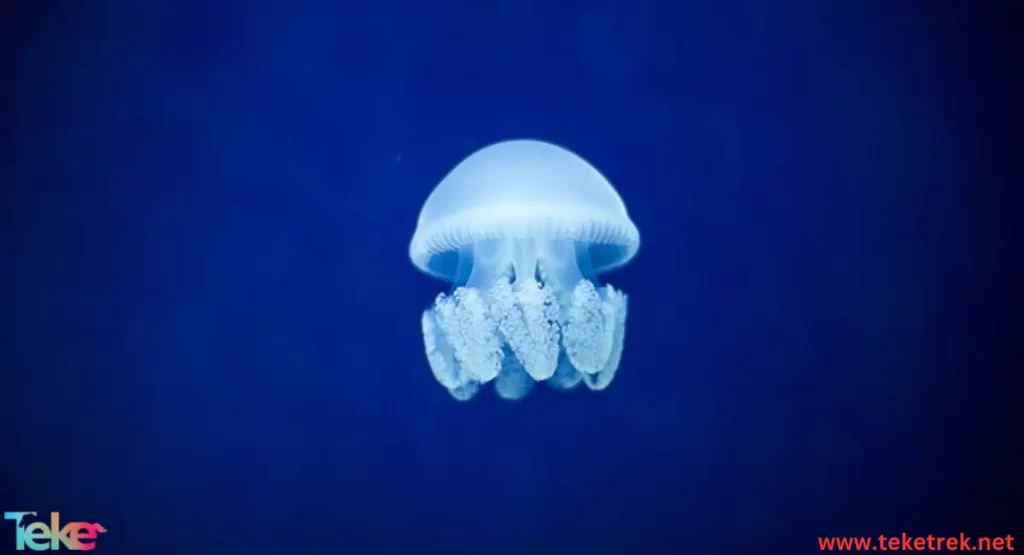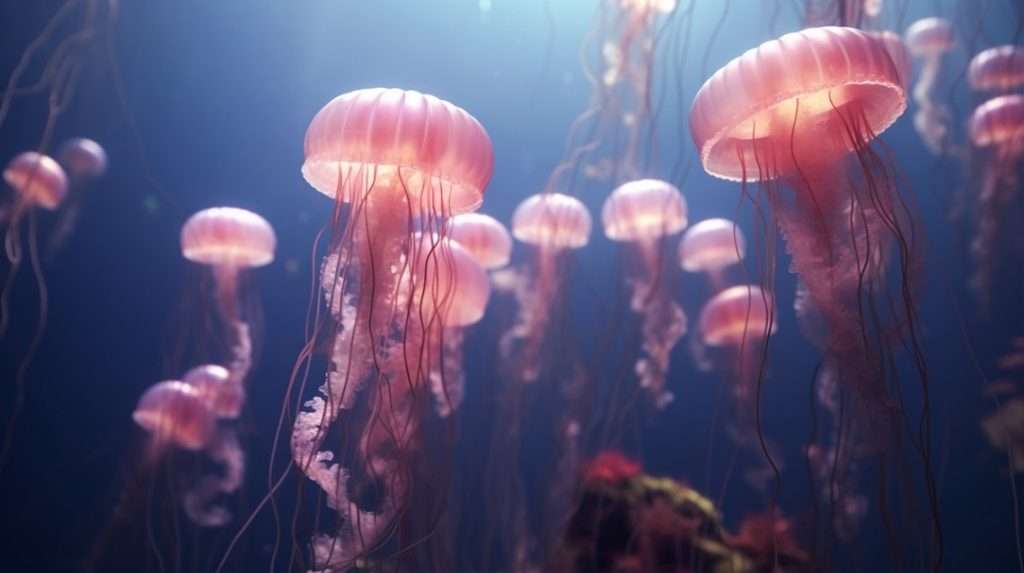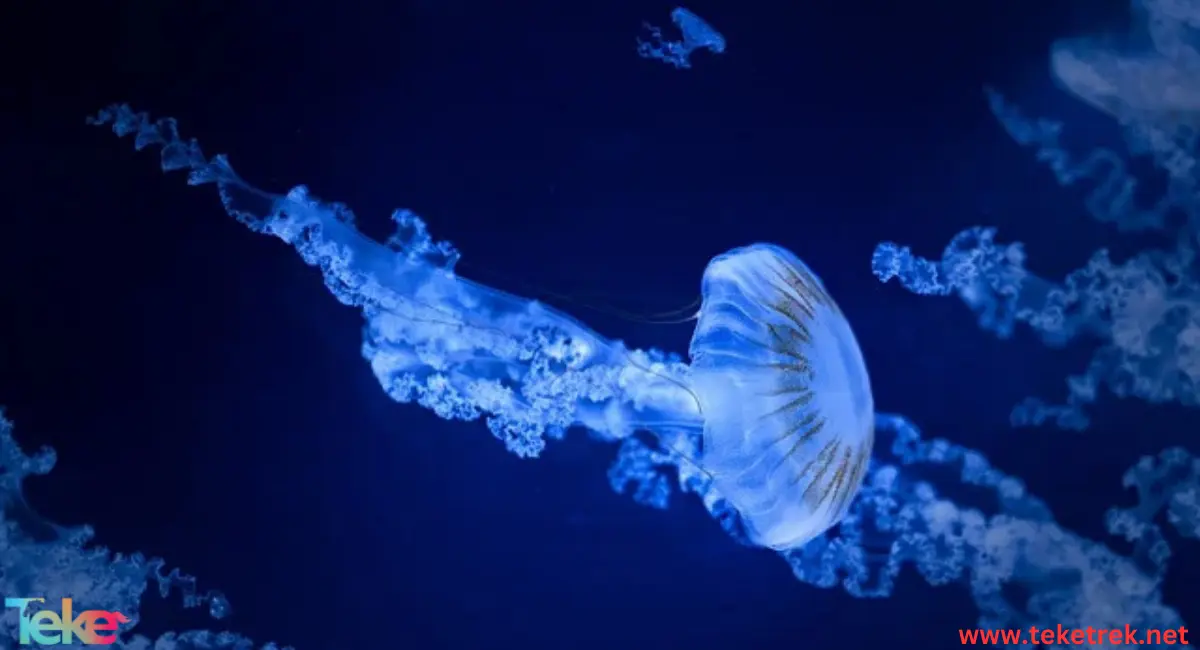The Jellyfish is an extraordinary creature, although disliked by many, especially swimmers, due to its stings that spoil their enjoyment in the sea. However, it is amazing with its stunning colors that constantly change in the water and can glow in the depths of the seas, as well as being very beneficial to humans.
In this article in TekeTrek Website, we will introduce you to the most important information related to this object. Follow along with us.
About the Jellyfish
The Jellyfish Scientific Name is Turritopsis dohrnii
- A marine organism belonging to the phylum Cnidaria or Porifera and classified as an invertebrate “lacking a vertebral column.”
- It has a transparent bag-like shape with a gelatinous texture, resembling bells or umbrella shapes.
- Jellyfish have thousands of stinging cells located at their ends, each containing thousands of sacs carrying toxic substance.
- Some jellyfish species are bioluminescent, meaning they glow in the dark.

Description and Shape of Jellyfish
- It is primarily composed of water, which makes up 98% of its body.
- The body of a jellyfish consists of the epidermis (outer layer), gastrodermis (inner layer), mesoglea (jelly-like substance between the epidermis and gastrodermis), and the gastrovascular cavity, which functions as both mouth and anus. It also includes the tentacles surrounding the edges of the jellyfish’s body.
- It has a bell-shaped body with an opening that serves as both mouth and anus simultaneously.
- Jellyfish have no brain, heart, bones, blood, eyes, or stomach. Nutrients are absorbed directly into the gastrovascular cavity.
- The diameter of jellyfish bodies ranges from 2 to 40 cm. They vary in size and color, with some being white, while others may be orange, brown, pink, red, or blue. There are also transparent jellyfish, such as moon jellyfish.
- The body of a jellyfish is generally made of a gelatinous material and a watery tissue called “mesogloea,” which gives it its transparent and fragile appearance.
Strange Facts about Jellyfish
- Jellyfish is one of the oldest living creatures, with a history dating back over 600 million years.
- Some types of jellyfish can regenerate relatively quickly if injured, as they can grow new arms to replace damaged ones.
- Jellyfish are bioluminescent, meaning they can produce faint light known as “bioluminescence” or “marine light.” They use this light as a defense mechanism and to attract prey.
- Some species of jellyfish have tentacles containing sensitive cells that carry a deadly toxin. Touching these tentacles can lead to poisoning for predators or humans.
- Jellyfish possess remarkable abilities that make them immortal creatures, as they do not die naturally except through external influences.
- Jellyfish can gather in numbers reaching hundreds or thousands in cases of ocean pollution.
- There are approximately 25 edible species of jellyfish, which have a salty taste and are cooked and added to pickles and salads.
- One of its prominent behavioral characteristics is mass migration, where large gatherings of jellyfish ascend from the ocean floor to the surface resembling a large flower, occurring twice annually.
- Jellyfish spend most of their lives searching for food or escaping from predators.
- They move a lot, spinning around themselves and swimming at high speeds, and are considered to have low intelligence as they lack a brain for thinking.
- Jellyfish are solitary creatures and hide from sunlight during the day.
- Despite lacking a brain in their head, jellyfish have clusters of nerve cells that help them swim and respond to stimuli.
Locations of Jellyfish
- Jellyfish have been found in most oceans and seas around the world. They inhabit warm tropical waters and are fast in reproduction and spreading.
- Some species prefer cold seas like the lion’s mane jellyfish.
- Most jellyfish species live on or near the ocean’s surface and swim freely or drift with the currents.
Reproduction in Jellyfish
- Jellyfish reproduce without the need for males and females.
- Jellyfish go through two stages of growth: the pre-adult stage and the adult stage. During the adult stage, the jellyfish can reproduce and produce other jellyfish before eventually dying.
- They reproduce by laying eggs, which they release into the water. These eggs then settle in a suitable location and remain there until they hatch into larvae, which eventually develop into adult jellyfish and complete their life cycle before dying.
- Most jellyfish live for a few weeks to several months, although some species can live for a year or more.
What does jellyfish eat
- Jellyfish primarily feed on plankton, crustaceans, small fish, as well as larvae and fish eggs. They consume their food and expel undigested waste through their mouth.
- Some species of jellyfish feed on both animal and plant plankton.
- Predators of jellyfish include sharks, swordfish, sea turtles, and penguins.
Jellyfish Sting
- The sting of a jellyfish is one of the most intriguing aspects of these creatures. Despite being slow-moving, they possess stinging cells that aid in defending themselves against larger predators and can immobilize various fish.
- When a jellyfish stings, its venom can potentially kill a human in less than five minutes. It’s said that this venom can remain in the body for many years.
- Scientists suggest that these gelatinous creatures are responsible for the deaths of 10,000 people annually.
Symptoms of Jellyfish Stings
- Burning or stinging sensation, accompanied by itching.
- Swelling and pain in the leg or arm.
- Jellyfish stings can cause stomach pain, nausea, vomiting, and headaches.
- Pain and muscle spasms, heart problems, and difficulty breathing.
- Sting may lead to fainting and dizziness.
Is a jellyfish sting dangerous?
Yes, a jellyfish sting can be dangerous and cause painful symptoms such as burning, swelling, and headache. In severe cases, it can lead to fainting, dizziness, and difficulty breathing.
Types of Jellyfish
- Scyphozoans: There are about 200 known species, including the moon jellyfish, crown jellyfish, and sea nettles.
- Lion’s Mane Jellyfish: The largest jellyfish in the world, with a body length of about 1.83 meters and tentacles reaching up to 30 meters. It has an orange coloration.
- Moon Jellyfish (Aurelia aurita): One of the most famous types, characterized by a white disk-shaped body and short, fine tentacles.
- Mushroom Cap Jellyfish: A small jellyfish with a body the size of a flying ball, and longer tentacles that lack claws.
- Cannonball Jellyfish: Dark red in color with long tentacles.
- Box Jellyfish: One of the largest and most dangerous jellyfish species, resembling a basketball-sized bell with tentacles reaching up to ten feet.
- Upside-Down Jellyfish: Its body length reaches 20 cm, with tentacles 2-3 times the width of the bell. It is commonly seen in the summer.
- Comb Jelly or Sea Walnut: Rarely seen at the surface except during spring.
- Pink Comb Jelly: Cylindrical in shape and pink or brown in color.


Uses of Jellyfish
- Food: Some countries use jellyfish as food, cooking them and serving them as culinary dishes.
- Medicinal Purposes: In some countries, jellyfish are used in therapy to remove toxins from stings. Extracts from jellyfish are used in medicine to treat conditions such as gout and hypertension.
- Health Benefits: Consuming jellyfish is believed to reduce the risk of asthma and promote eye and brain health, while also preventing cardiovascular diseases.
- Industrial Applications: Jellyfish are utilized in the production of cleansers and some cosmetic products, as well as skin moisturizers.
How does a jellyfish die?
A jellyfish dies after completing its life cycle. When it reaches the end of its life, the jellyfish stops feeding and gradually deteriorates in health. Its body may decompose and turn into organic matter due to natural decay or be preyed upon by predators in the marine environment.
FAQ about the Jellyfish
- What are 5 facts about jellyfish?
Sure, here are five brief facts about jellyfish:
- Ancient creatures, existing for over 500 million years.
- They have gelatinous bodies with stinging tentacles.
- Thousands of species inhabit oceans worldwide.
- Some species can produce bioluminescent light.
- Their life cycle involves complex stages of reproduction and development.
- Is it OK to touch a jellyfish?
It’s generally not advisable to touch jellyfish, as many species have stinging cells in their tentacles that can cause painful stings. Even some seemingly harmless jellyfish can have mild toxins that may cause irritation or allergic reactions in some people. It’s best to admire them from a safe distance in the water.
- Can jellyfish still sting you?
Yes, jellyfish can still sting you even if they are dead or washed up on shore. Their stinging cells, called nematocysts, can remain active for some time after the jellyfish dies, especially if they are disturbed or touched. It’s important to avoid touching stranded jellyfish to prevent accidental stings.
- What do you do if you get stung by a jellyfish?
If stung by a jellyfish, the first step is to remain calm and avoid panicking. Then, you should rinse the affected area with cold water for 15 to 30 minutes to reduce pain and swelling. Vinegar or vinegar solution can be used to alleviate the pain. Afterwards, seeking medical help is advised if the symptoms are severe or if the sting is strong, as some people may require specialized medical treatment.
- What is the danger of jellyfish?
Jellyfish can be dangerous due to their ability to release lethal toxins when stung. The sting can cause painful symptoms such as burning, swelling, and headache, and in severe cases, it can lead to fainting, dizziness, and difficulty breathing. In some cases, severe stings may require urgent medical care. If stung by a jellyfish, it is important to seek appropriate medical treatment to reduce symptoms and potential risks.
- Is it OK to eat jellyfish?
Some cultures consume jellyfish as food, but caution should be exercised when consuming them. Some species of jellyfish may contain dangerous toxins capable of causing negative health effects in humans.
- Where do jellyfish come from?
Jellyfish inhabit the world’s oceans, found in the waters of tropical, temperate, and cold seas and oceans. These marine creatures are present in the waters of seas and oceans worldwide, with their species and habitats varying based on environmental and climatic conditions.


In conclusion, the Jellyfish enchanting creature, embraced by the seas and oceans, maintains its distinct allure among other organisms. However, it’s essential to protect ourselves from it to prevent its captivating beauty from turning into a source of fear and terror.






